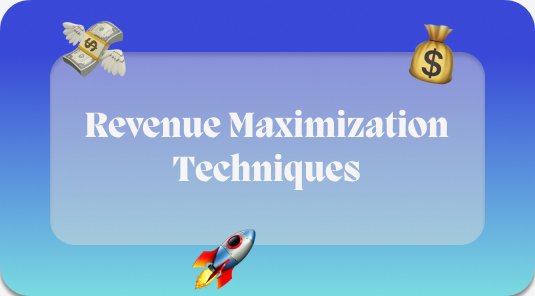Customer Segmentation for Personalized Revenue Strategies

Customer Segmentation for Personalized Revenue Strategies: Leveraging Data-Driven Insights
Customer Segmentation for Personalized Revenue Strategies focuses on the strategic division of a customer base into distinct groups that possess similar needs or characteristics. This approach enables companies to more accurately target their marketing efforts, providing personalized experiences that can lead to increased customer loyalty and revenue growth. By understanding and responding to the unique preferences and behaviors of each segment, businesses can align their products and communication strategies to meet the specific demands of their customers.

The power of customer segmentation lies in its ability to turn vast amounts of data into actionable insights. These insights inform decisions on product development, marketing initiatives, and customer engagement tactics. Leveraging segmentation, businesses can design highly targeted campaigns that resonate with individual customer groups, thereby optimizing resource allocation and maximizing return on investment. Companies that harness this strategy effectively can expect to see a significant positive impact on their bottom line.
Key Takeaways
- Customer segmentation tailors marketing to increase loyalty and revenue.
- Insights from data segmentation guide targeted product and marketing strategies.
- Effective segmentation fosters personalized customer experiences and business growth.
Understanding Customer Segmentation
Customer segmentation enables businesses to tailor their marketing efforts and product offerings to distinct groups within their customer base, enhancing both customer experience and revenue potential.
Definition and Importance
Customer segmentation is the process of dividing a business's customer base into groups of individuals that are similar in specific ways relevant to marketing, such as age or purchasing behaviors. This approach is crucial because it allows for more personalized marketing strategies and can lead to increased customer loyalty and revenue. Recognizing the distinct needs and preferences of each customer segment leads to more effective targeting and message delivery.
- Demographic Segmentation: Involves categorizing customers based on variables such as age, gender, income, education, and occupation.
- Geographic Segmentation: This separates customers based on their location, such as countries, cities, or even neighborhoods, to deliver region-specific offerings.
- Psychographic Segmentation: Goes deeper by classifying customers based on their lifestyles, values, interests, and opinions.
- Behavioral Segmentation: Focuses on how customers interact with brands, their purchasing patterns, product usage, and feedback.
Types of Customer Segmentation
Each type of segmentation helps a company understand and predict customer behaviors, thereby crafting strategies designed to appeal to one or more specific segments effectively.
- Demographic: Easy to measure and a common starting point for segmentation; for example, targeting products based on life-stages can greatly improve relevance and connection with the audience.
- Geographic: Seasonal marketing efforts can be honed using geographic data, customizing promotions according to the regional climate or events.
- Psychographic: By assessing lifestyle preferences, companies create image-centric campaigns that resonate on a personal level with customers.
- Behavioral: Analyzing past shopping habits helps predict future behaviors, allowing businesses to anticipate needs and build proactive strategies.
By understanding and implementing strategies based on these segmentation types, companies stand to deliver a more personalized service that should drive customer engagement and business growth.
Developing Effective Segmentation Strategies
When setting out to develop effective segmentation strategies, it's crucial to establish focused goals and select a robust model that aligns with your marketing efforts. These strategies are tailored to classify customers into segments that reflect varying needs and behaviors, facilitating more precise targeting.
Segmentation Goals and Objectives
An imperative first step in designing a segmentation strategy is to delineate your segmentation goals and objectives. This sets the stage for a segmentation strategy that is in line with the organization's overarching marketing efforts. Goals often include enhancing customer retention, identifying potential markets, or customizing communication. Objectives may range from increasing engagement rates to driving sales within a particular customer niche.
Designing a Customer Segmentation Model
Creating an effective customer segmentation model involves understanding the different types of customer segmentation—demographic, geographic, psychographic, and behavioral. A model should dissect the customer base into groups sharing common characteristics, thereby enabling businesses to cater to specific customer needs. It’s critical to gather and analyze data to ensure that these groups reflect real patterns in customer behavior and preferences.
Demographic Segmentation: Often based on age, gender, income, or education, this type illustrates broad traits that can predict customer behavior.
Geographic Segmentation: This type divides customers by location, useful for campaigns targeting regions with similar climate, culture, or buying habits.
Psychographic Segmentation: Here, psychological attributes like lifestyle, values, and beliefs are used to group customers, offering a deeper understanding of the intrinsic factors driving purchasing decisions.
Behavioral Segmentation: This method focuses on actions such as purchase history, product usage frequency, and brand loyalty, offering a dynamic view of customer interactions with the business.
Designing these models requires careful consideration to ensure that the segmentation maximizes relevance and allows for personalized marketing that resonates with each customer. Commitment to an ongoing iterative process to refine the models is recommended, as this ensures the segmentation remains current and effective over time.
Data-Driven Customer Insights
In today's competitive landscape, data-driven customer insights serve as the lifeblood for personalization and strategic market segmentation. Businesses rely on leveraging diverse data sources and sophisticated analytics to understand and cater to individual customer preferences and behaviors.
Leveraging Data Sources
Companies use various data sources such as CRM systems, social media interactions, transaction histories, and website analytics to gather comprehensive customer information. CRM systems, in particular, are integral, storing a wealth of customer interactions, sales data, and service records. This cross-channel information offers a granular view of customer behaviors and preferences.
Data Collection and Analysis
Effective customer data collection and analysis are critical for translating raw data into actionable insights. Businesses employ advanced data and analytics tools to segment customers and predict future behaviors. By analyzing patterns within the data, companies can identify potential opportunities for upselling, retention, and personalized marketing, turning customer insights into increased revenue streams.
Tailoring Marketing and Personalization
Effective personalized marketing is no longer optional but a crucial aspect of modern marketing campaigns. To maximize revenue, businesses must tailor marketing strategies to individual customer needs and create personalized experiences that resonate with their audience.
Customer-Centric Marketing Campaigns
In the realm of customized marketing efforts, the focus has shifted to building campaigns that center around the customer. A key trend is the transition from broad outreach to customer-oriented marketing, which harnesses detailed insights about customer preferences and behaviors. Leveraging data analytics, businesses are able to segment their audience into distinct groups with specific characteristics and interests, allowing for more targeted and efficient marketing campaigns.
Key points in customer-centric campaigns include:
- Identification of unique customer segments
- Data-driven strategy formulation
- Implementation of targeted communications
Through these targeted tactics, companies achieve a higher return on investment while improving customer satisfaction.
Creating Personalized Experiences
Personalized experiences are the hallmark of successful personalized marketing campaigns. Personalization transcends mere product recommendations, encompassing all touchpoints a customer has with a brand. It is about crafting a unique narrative for every customer based on their interactions, preferences, and purchase history.
Effective personalized experiences may involve:
- Customized email campaigns
- Tailored website content
- Individualized product offerings
The capability to deliver such customized content has been made possible with advancements in technology and data analysis. This level of personalization has been shown to drive customer engagement, elevate brand loyalty, and ultimately, increase revenue streams for businesses.
Measuring Segmentation Effectiveness

To ascertain the impact of customer segmentation on personalized revenue strategies, one must assess key performance indicators such as customer engagement and make data-driven adjustments for continuous improvement. It is crucial to link these metrics to the customer journey to facilitate increased sales and enhance customer and brand loyalty.
Customer Engagement Metrics
Customer engagement metrics offer a snapshot of how effectively a segmentation strategy fosters interaction between the company and its customers. One should monitor:
- Conversion Rates: These figures will indicate whether the targeted messaging is resonating with each segment and compelling them to take action.
- Customer Lifetime Value (CLV): This metric reflects the total revenue a company can expect from a customer over the duration of their relationship. An increase in CLV suggests that segmentation is positively affecting customer loyalty.
- Net Promoter Score (NPS): NPS gauges brand loyalty by measuring customer willingness to recommend the company's products or services. A high score can be indicative of successful segmentation.
In the context of the customer journey, these metrics can pinpoint where customers are most engaged and where there might be room for improvement.
Analytics for Continuous Improvement
Analytics are essential for refining segmentation strategies. They should be leveraged to:
- Track Behavioral Changes: By observing shifts in how different segments interact with the company, businesses can adapt their approach to maintain alignment with customer needs and preferences.
- A/B Testing: Through controlled experiments comparing two versions of a segment's experience, companies can gain insights into which strategies are most effective at driving sales.
- Sales Trend Analysis: Examining sales trends helps in understanding how well segmentation is working and identifies which segments are most profitable.
Ongoing analysis informs a company’s approach to segmentation, ensuring that it remains dynamic and responsive to customer behavior, ultimately leading to sustained revenue growth.
Integrating Segmentation into Business Operations

Successful integration of customer segmentation into business operations can lead to more tailored product development and customer service enhancements. Employing segmentation allows for the creation of strategic initiatives that align closely with consumer needs, fostering a competitive edge and deeper customer insights.
Segmentation in Product Development
In product development, customer segmentation plays a critical role in identifying and prioritizing which features or services should be developed to meet the specific needs of different customer groups. For instance, data-driven segmentation can pinpoint gaps in the market that certain customer segments may experience, leading to innovative products designed with those particular users in mind. This targeted approach not only facilitates customized product solutions but also drives a company's competitive advantage in the marketplace by addressing unmet consumer demands.
- Identify: Use segmentation to recognize customer preferences and pain points.
- Prioritize: Develop products tailored to the needs of the most valuable segments.
- Customize: Create specialized features that resonate with specific groups.
Role of Segmentation in Customer Service
Customer service benefits profoundly from segmentation by allowing businesses to anticipate and address the varied needs of different customer segments. By understanding the characteristics of each segment, companies can customize their support and communications. This might entail offering dedicated support lines for high-value customers or deploying chatbots for tech-savvy users who prefer quick, digital solutions. This personalized approach not only enhances the customer relationship but also provides better customer insights, which can be leveraged to refine the overall customer service strategy.
- Anticipate Needs: Segment-based customer profiles enable predictive customer service.
- Customize Support: Tailor support channels and communication styles to fit each segment.
- Enhance Insights: Use feedback from segmented groups to continuously improve service offerings.
Future Trends in Customer Segmentation
The landscape of customer segmentation is evolving rapidly, driven by technological innovation and shifting customer behaviors. Businesses must leverage these changes to create more targeted revenue strategies.
Technological Advancements in Segmentation
Technological advancements are reshaping the tools and methodologies used in customer segmentation. Notably, customer segmentation software is incorporating the use of advanced algorithms and artificial intelligence (AI) to facilitate precision marketing. These software solutions enable marketers to move beyond traditional demographic and geographic bounds to embrace technographic segmentation. Technographic segmentation identifies prospects based on their technological profiles, such as the devices they use or software they interact with, to inform the deployment of new products.
The integration of AI into market segmentation tools allows for real-time data analysis and pattern recognition. Companies like Sephora have been utilizing chatbots for not just customer service, but also to analyze customer interactions for deeper insights into individual preferences and behaviors.
Adapting to Changing Consumer Patterns
Responding to changing consumer patterns, segmentation is becoming more dynamic and granular. Businesses are focusing on creating detailed customer personas, crafting individualized experiences that cater to highly specific customer needs and preferences. This approach enables organizations to not only increase customer retention but also to capitalize on upselling and cross-selling opportunities.
To navigate this complex environment, businesses are increasingly adopting an agile mindset, continually updating their segmentation strategies in response to consumer feedback and market changes. The evolution of segmentation is characterized by its growing sophistication, as companies harness more nuanced data to inform their strategic decisions.
Forbes Advisor provides a comprehensive view on the importance and application of segmentation in its guide on Customer Segmentation. Meanwhile, literature like the piece from Springer delves into a scholarly review of customer segmentation methods, which are increasingly important for personalized customer approaches.
Stay up to date with our blog
Dive into our informative and engaging blog posts to stay informed on the latest trends in the Webflow & Shopify world as well on actionable tips to make your website work for you.



Contact us
We're only 1 email, call, message or meeting away. We'd be happy to help with your query. Book in a time on our calendar so we can speak.





